Case Report - (2024) Volume 10, Issue 4
Placental Teratoma Case Report and Review of the Literature
De Ganzo Suárez Tania1*,
Caamiña Álvarez Sara1,
Pérez Gómez A1,
Rodríguez T1 and
Vilar M2
1Obstetrics and Gynecology Service, Our Lady of Candelaria University Hospital, Santa Cruz de Tenerife, Tenerife, Canary Islands, Spain
2Pathological Anatomy Service, Our Lady of Candelaria University Hospital, Santa Cruz de Tenerife, Tenerife, Canary Islands, Spain
*Correspondence:
De Ganzo Suárez Tania, Obstetrics and Gynecology Service, Our Lady of Candelaria University Hospital, Santa Cruz de Tenerife, Tenerife, Canary Islands,
Spain,
Tel: +34922600526,
Email:
Received: 04-Jun-2024, Manuscript No. IPGOCR-24-21436;
Editor assigned: 06-Jun-2024, Pre QC No. IPGOCR-24-21436 (PQ);
Reviewed: 18-Jun-2024, QC No. IPGOCR-24-21436 (Q);
Revised: 24-Jun-2024, Manuscript No. IPGOCR-24-21436 (R);
Published:
01-Jul-2024, DOI: 10.36648/2471-8165.10.4.31
Abstract
Objective: Placental teratoma is a very rare no trophoblastic benign tumour. The tumour we present lays between
amnios and chorion. It contains disorganized tissues (skin, bone, fat, etc.). Lack of a recognizable umbilical cord
and no recognizable skeletal development are used as a differential diagnostic criterion for placenta teratoma. In
our case umbilical cord was absent; however, the tumour was connected to the placenta by a vascular channel
covered only by fetal membranes without Wharton´s jelly. We present a case to review the literature.
Material and methods: A 29 years old woman and 37 weeks of gestation. On the scan we found out a heterogenous
mass of 8, 3 × 8, 5cm arising from the placenta.
Results: The diagnosis of the placental teratoma is based on prenatal ultrasound and histological examination of
the placenta. This tumour does not appear to increase the risk of a fetal malformation. The differential diagnosis
must be with fetus acardius amorphous. Maternal and fetal outcome were good.
Conclusion: Placental teratoma is a very rare no trophoblastic benign tumour.
Introduction
Teratomas are neoplasms produced by totipotential
embryonic germ cells and thus can be composed by virtually
any type of tissue. They contain elements derived from
multiple germ cell layers. Placenta is an extremely rare site
for this tumour, to date, 40 cases of placental teratoma and
21 cases of umblical cord teratoma have been reported in the
literatura [1] after the first case was described by Morvilli, et
al, in 1925 [2]
Case Presentation
A twenty-nine years old fourth gravida with a previous
healthy child was referred to our hospital at 37 weeks of
pregnancy due to fetal breech position to performance a
cephalic external version. Combined screening test at first trimester was low risk and anomaly scan was normal. A routine
scan to assess fetal position, fetal well-being, amniotic fluid
volume and placental position is always carried out before
doing a cephalic external version. In this scan the fetus was in
breech position, estimated fetal weight was normal, amniotic
fluid was normal and placenta was placed in the anterior
wall of the uterus. Close to the placenta we found out a
heteroechogenous mass with well-defined walls of 85x 82 mm
that seemed to be connected to the placenta by the amniotic
membranes.
There were some echogenic foci with acoustic shadows
inside the mass that suggested calcification. On Doppler
ultrasound examination, there was minimal vascularity on the
surface of the mass (Figure 1).
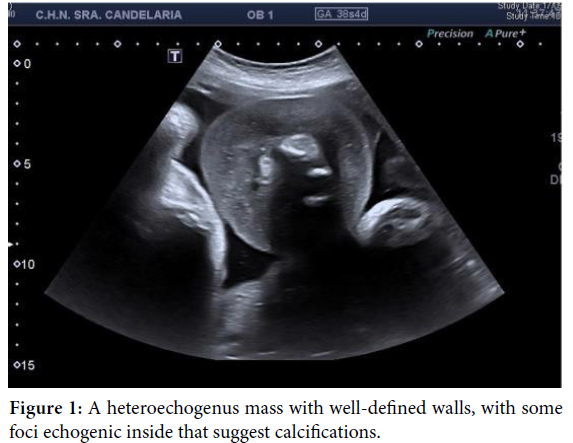
Figure 1: A heteroechogenus mass with well-defined walls, with some foci echogenic inside that suggest calcifications.
At thirty-eigth weeks the patient was posted for cesarean
section for breech presentation, and a live female baby of 3330gr. was delivered. There were no anomalies in the
neonate. The placenta weighted 690 gr. and measured 25 ×
14 × 4 cm. Maternal and fetal surfaces of the placenta were
unremarkable. The centrally inserted umbilical cord was 20cm.
long and contained two arteries and one vein.
The tumour was attached to the membranes by a vascular
pedicle formed by a vein and an artery covered by fetal
membranes without Wharton´s jelly. The arterial supply was
obtained from an artery in the pedicle with its origin in one
of the large fetal arteries on the chorionic surface of the
placenta. Venous drainage was through a vein in the pedicle,
connected to a fetal vein on the chorionic surface. The mass
weighted 192gr. And mesuared 8 × 7 × 5 cm. (Figure 1). The cut
surface of tumor was solid, multinodular, yellow in colour and
heterogenous with adipose tissue, cartilage, bone structures
and hair (Figure 2 and Figure 3).
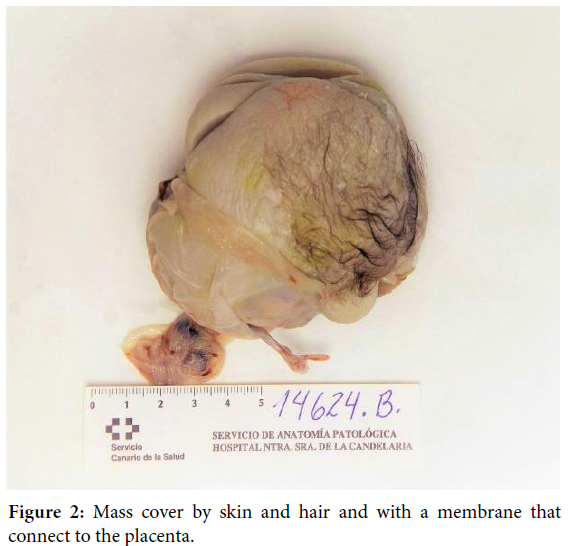
Figure 2: Mass cover by skin and hair and with a membrane that connect to the placenta.
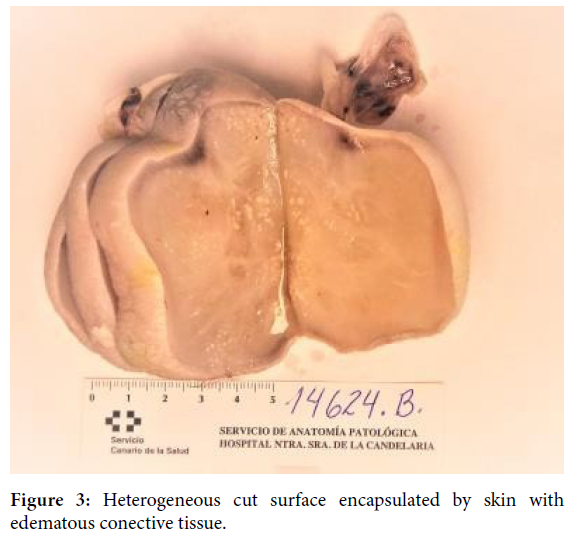
Figure 3: Heterogeneous cut surface encapsulated by skin with edematous conective tissue.
On histological examination (Figure 4, Figure 5 and Figure 6)
the tumor was covered by skin and appendages including sweat
glands, sebaceous glands and well- developed hair follicles. The deepers layers of the tumor were composed of different tissues
within a vascular, loosely cohesive and edematous connective
tissue. Small blood vessels and peripheral nerve fibers with ganglion cells were scattered throughout the adipose tissue
intermingled with brain tissue and striated muscle fibers. The
central area of the tumour contained squamous and colonictype
mucosa, renal embryonic tissue and bone.
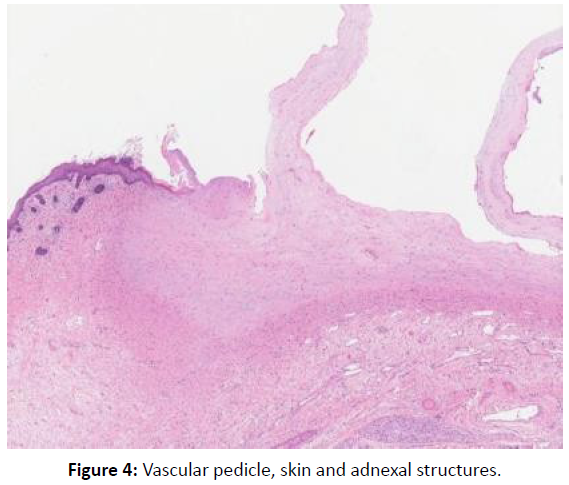
Figure 4: Vascular pedicle, skin and adnexal structures.
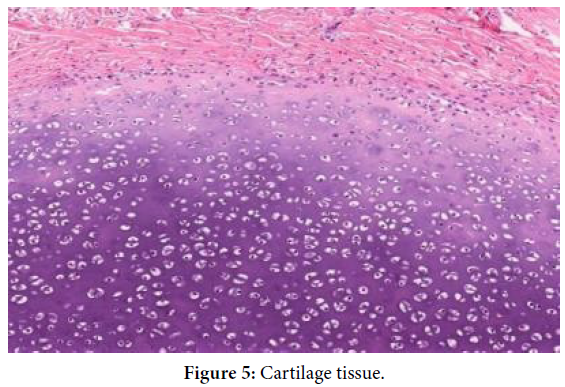
Figure 5: Cartilage tissue.
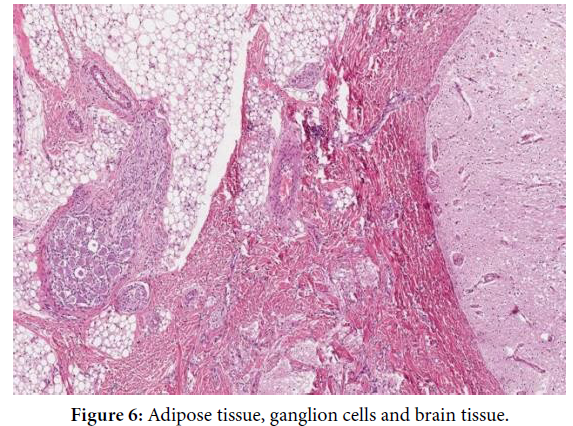
Figure 6: Adipose tissue, ganglion cells and brain tissue.
No immature neuropithelium or axial-type skeletal
organization were found in the tumour. No umbilical cord was
recognizable.
Discussion
Placental teratomas are rare tumours with an unclear
histiogenesis [1]. However, there is considerable evidence that
placenta teratoma may originate from the abnormal migration
of embryonic germ cells [2] These cells migrate through the
umbilical cord before arriving in the placenta [3]. After the
third week of development, primordial germ cells that arise in
the dorsal wall of the yalk sac begin migration to the genital
ridge along the dorsal mesentery of the hindgut. During this
stage, some primordial germ cells may go stray and migrate
to a more distant midline structure, like the mediastinum,
where a teratoma of development may arise later in life. At the
beginning of development, the primitive gut investigates the
umbilical cord, and the well-formed intestinal mucosa can be
seen in the cord up until the third month and occasionally the
fourth month. It is possible to hypothesise that the aberrant
germ cells can migrate through this evaginated hind gut and
give rise to a teratoma of the umbilical cord. If they progress
into the loose connective tissue of the umbilical cord and
continue further migration, they may arrive at the fetal surface
of the placenta between amnion and chorion [4-6].
The differential diagnosis must be done with fetus
amorphous acardius. Fetus acardius is a rare fetal malformation
characterized by the absence of fetal heart and displays
no resemble to a fetal embryo [7,8]. It is always happen in
monozygotic,
monochorionic twins [9] or rarely, triplets [10] Diagnosis
of fetus acardius depends on the presence of a craniocaudal
skeletal organization and an umbilical cord [4] Fetus acardius
is related with hydramnios, congestive heart failure, preterm
delivery and even death of the co-twin, however; teratomas
are rarely associated with fetal distress and have a good fetal
outcome.
The case was diagnosed as teratoma, and not as fetus
acardius, because the absence of an umbilical cord and lack
of axial-type skeletal organization [5]. The rest of the placenta
showed syncytial knots and some foci of calcification, which
are features of full-term placenta.
Conclusion
Placental teratoma is a very rare no trophoblastic benign
tumour.
References
- Elagöz S, Aker H, Cetin A. (1998) Placental teratoma: A case report. Eur J Obstet Gyn R B 80(2): 263-265.
Google Scholar, Crossref, Indexed at
- Morville P.A.U.L. (1925) Une teratoma placentaire. Obstet Gynecol 11(1925): 29-32.
Google Scholar
- Shimojo H, Itoh N, Shigematsu H, Yamazaki T. (1996) Mature teratoma of the placenta.PatholInt 46(5): 372-375.
Google Scholar, Crossref, Indexed at
- Fox H, Butler‐Manuel R. (1964) A teratoma of the placenta. J Pathol Bacteriol 88(1): 137-140.
Google Scholar, Crossref, Indexed at
- McHenry A, Morotti R, Hui P. (2022) Placenta teratoma or acardiac fetus amorphous: A case study by DNA genotyping. Int J Gynecol Pathol 41(1): 51-58.
Google Scholar, Crossref, Indexed at
- Fox H. (1986) Pathology of the placenta.ClinObstetGynaecol13(3): 501-519.
Google Scholar, Crossref, Indexed at
- Alderman B. (1973) Foetus acardius amorphus. Postgrad Med J 49 (568): 102-105.
Google Scholar, Crossref, Indexed at
- Moore TR, Gale S, Benirschke K. (1990) Perinatal outcome of forty-nine pregnancies complicated by acardiac twinning. Am J Obstet Gynecol 163(3): 907-912.
Google Scholar, Crossref, Indexed at
- Wong AE, Sepulveda W. (2005) Acardiac anomaly: Current issues in prenatal assessment and treatment.Prenatal Diag25(9): 796-806.
Google Scholar, Crossref, Indexed at
- Dahiya P, Agarwal U, Sangwan K, Sen J. (2004) Antenatal diagnosis of twin-reversed arterial perfusion sequence (acardiac amorphous) in a triplet pregnancy: Case report. Arch Gynecol Obstet (269): 147-148.
Google Scholar, Crossref, Indexed at
Citation: Tania DGS, Sara CA, Gómez PA, Rodríguez T and Vilar M. (2024) Placental Teratoma Case Report and Review of the Literature. Gynecol Obstet Case Rep. Vol.10 No.4:31.
Copyright: © Tania DGS, et al. This is an open-access article distributed under the terms of the Creative Commons Attribution License, which permits unrestricted use, distribution, and reproduction in any medium, provided the original author and source are credited.







